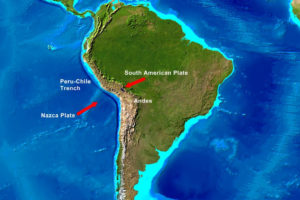The Andes is a mountain range on the west coast of South America. It is the longest continental mountain system in the world. The mountains run from the Caribbean to the tip of South America. The mountain system is over 7,200 kilometers long. The convergence of oceanic and continental plates created the Andes.
Origin of the Andes

Convergence of Tectonic Plates
The South American tectonic plate is a continental plate. Continental plates are light and have a low density. The Nazca plate is an oceanic plate that lies to the west of the South American plate. In contrast, it consists of heavier and more dense materials.
The Nazca plate is slowly moving to the east. The South American plate moves to the west. The collision of the two plates creates a subduction zone. At the subduction zone, the heavier Nazca plate dives below the South American plate.
Folding and Faulting
This subduction process has been going on for 50 million years. Subduction has produced two large landforms. First, the Andes is the result of uplift from the deformation of the South American plate. This deformation is due to folding and faulting.
On the other hand, in the Pacific Ocean, subduction has created a deep sea ocean trench. This is the Chile-Peru Trench. The trench is over 8,000 meters deep.
Volcanic Activity
In addition to folding and faulting, the Andes is built by volcanic activity. There are over 180 active volcanoes in the mountain system. As the oceanic plate moves under the continental plate it is heated and melted. This molten material can become a pool of magma for volcanic eruptions.
Historical Significance of the Andes
In ancient times, the Andes was home of several civilizations. The largest was the Inca Empire. The empire had the technology to build roads, aqueducts, and buildings. The Inca Empire lasted until the early 1500’s. The Spanish defeated the Inca people through military action and introduction of diseases.
Today, the Andes is the home of large cities and national capitals. The mountains also provide a wealth of natural resources.
Reflections
Vocabulary
- convergence
- folding
- subduction zone
Notes
- The Andes was created by the convergence of oceanic and continental plates.
- Plate convergence caused uplift through folding and faulting.
- The mountains have been home to ancient and modern civilizations.

